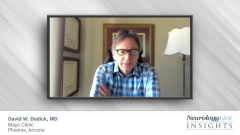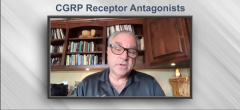
Gepants for Acute Migraine: Patient Management
Episodes in this series

David W. Dodick, MD: When you’re conducting a clinical trial, you determine what is going to be a clinically meaningful difference compared with placebo and then power the trial to try to show whether there’s a difference. Once you’ve shown that there is a statistical separation from active drug compared with placebo, then you’ve surpassed what you’ve set as your clinically meaningful threshold.
After that, I stop looking at placebo. The placebo response rate in the clinical trial is meaningless when I’m sitting in front of the patient trying to make a decision. And so I don’t talk about placebo response rates when I’m sitting with the patient. I simply tell them that in the clinical trial, when patients were treated for moderate or severe pain, about 20% or 21% were pain-free. That’s what I tell them, and I tell them this percentage of patients had relief of headache. To be quite honest, I don’t really talk about the most bothersome symptom, and I don’t get into those numbers. But I tell patients that in addition to relieving pain, these medications have the potential to relieve other symptoms that they’re experiencing. Then I tell them that the way we’re going to use it is we’re going to have them treated at the earliest onset of the attack while pain is still mild. If we treat while pain is mild, we may see better results than what was seen in clinical trials.
Once a drug has been proven to be superior to placebo based on a clinically meaningful threshold, or delta, or difference that was established at the beginning of the trial, there is no need to start looking at therapeutic gain or placebo response rates in clinical practice. For example, let’s say the active treatment had 20% pain-free response at 2 hours and placebo had a 10% response. The therapeutic difference is 10%. I don’t tell a patient, for example, that the pain-free response rate at 2 hours is about 10%, because it’s not. It’s 20%. The difference between placebo is meaningless when sitting with the patient, to be honest. You look at the magnitude of the effect in the active treatment group and what proportion of patients actually had relief of pain or became pain-free at 2 hours. That’s what you discuss with the patient.
These medications, rimegepant included, can show a difference at earlier time points on any of a number of outcome measures. That’s good. One of the frustrating things is that moderate and severe pain are lumped together. They shouldn’t be, because when treating moderate pain, you get incremental benefit. It’s unfortunate that we lump those 2 together. They should be separated. They’re 2 totally different pain states when you start treating patients. Be that as it may, the fact that you can get separation from placebo at earlier time points on any of a number of outcome measures tells you that this has the potential to work earlier than 2 hours. When we look at 2 hours, it’s important to know what happens at 2 hours. But patients don’t want to wait 2 hours. They would like relief as quickly as possible. Imagine taking something sitting down, looking at the clock, and thinking, “Oh my, I have to wait 2 hours now? I have to wait from 10 am to 12 pm to get some relief?” The onset of relief is actually as important to patients as how complete the relief is.
How quickly will they notice a meaningful difference? If they notice a reduction from severe to moderate pain in 20 to 30 minutes, even though that wouldn’t be captured in a clinical trial, that’s very meaningful to a patient. The onset of meaningful relief is something that’s really important and gets lost in the noise of these clinical trials. The fact that these drugs can work quicker, even when you treat pain that’s moderate or severe, means that if I treat it while pain is mild, I’m likely to get even more benefit earlier on—earlier than 2 hours.
That’s what those end points mean to me. I don’t really focus on 1 particular end point, because A) I’m going to be using the drug in a way that it wasn’t used in clinical trials, and B) it tells me that the drug can work more quickly than 2 hours, especially in the way we’re going to use it in practice. But even when you let patients go on and let their attack progress, it can still work in them in less than 2 hours.
Newsletter
Keep your finger on the pulse of neurology—subscribe to NeurologyLive for expert interviews, new data, and breakthrough treatment updates.

































